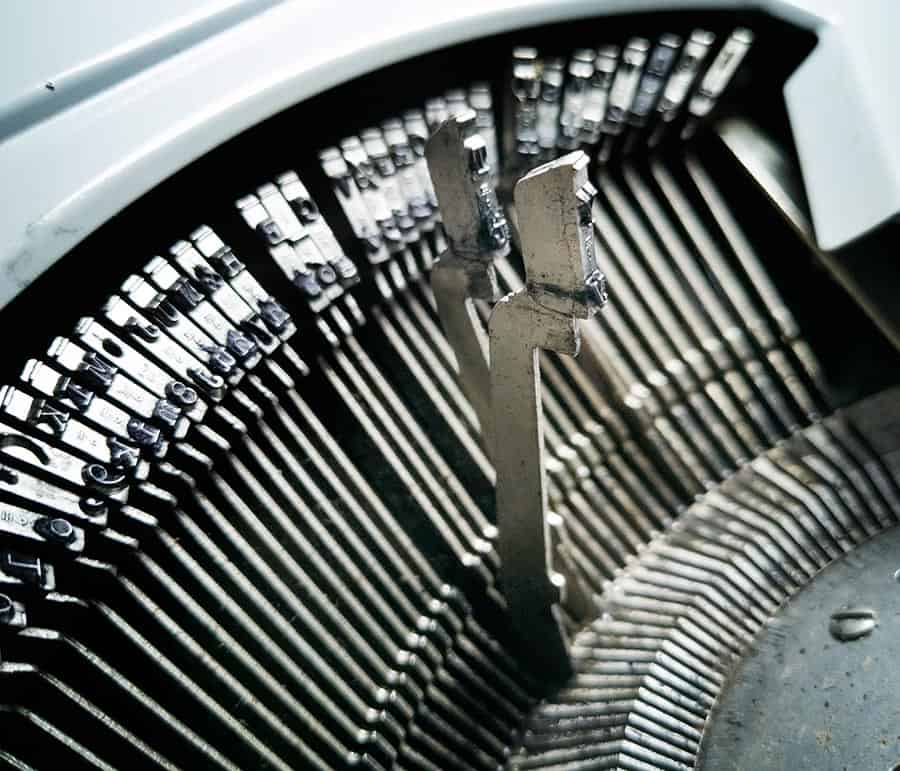
My oldest functional writing tool is this SilverReed portable typewriter. Photo by Mark Lyndersay.
BitDepth#1139 for April 05, 2018
My first technology skill was learning to type.
I didn’t see it that way then, but it was clear that if I was going to do anything useful in journalism, I needed to be mindful of the growing annoyance of subeditors who were demonstrably tired of my crapaudfoot handwriting.
Writing long hand has a particular elegance and deliberation to it, the words formed from the strokes of a pen – or for the less assured, pencil – on long sheets of ruled paper.
It’s a noble tradition that hasn’t survived in today’s fast paced world of news immediacy. Voice notes and interview recordings have nearly obliterated the era of shorthand notetaking, and I’ve long abandoned notebooks for a smartphone, bluetooth keyboard and Evernote on assignments.
Typing, as it turned out, has become a core skill for anyone doing journalism in the digital era and my own decision to tackle the learning curve with driven industry turned out to be quite sensible.
I used an incredibly old Smith-Corona for my lessons, which consisted of banging away at the keys while referencing an equally old and tattered Pitman’s handbook, a gift from sporting enthusiast Tansley Thompson’s sister.
Instead of sitting in a room full of young secretarial hopefuls, I battered away at the instructions and drills on the pages, long decades before Mavis Beacon would offer gaming as a way of learning the keyboard.
I eventually retired that typewriter, partly because changing the ribbon was like servicing a Model-T Ford and mostly because the subeditors who had complained about my handwriting were now making fun of my typed copy, which punched holes clean through the paper with every “p” and “o.”
Express Features Editor Kitty Hannays would ask for my copy then hold the page up to the light and, pointedly peering at the holes, announce that she’d found it.
The new typewriter was a SilverReed, a “portable” in pastel blue a third of the size of its monster predecessor.
I still own that typewriter, though I haven’t lifted its neat, moulded plastic cover in more than a decade. In some ways, it was the writing tool that most sealed my commitment to the craft of writing and tossing it out just seemed like a sour mix of disrespect and ingratitude.
At my first real job, as an assistant to the nonexistent Public Relations Manager at Colonial Life, I’d bring that typewriter along, only to meet its modern successor, the squat lump of plastic and metal labeled Selectric.
The IBM Selectric was the end of the physicality of typing, the calculated pressure of fingertips on a lever that brought the typebar, a hammer with an inverse of the character into the inked ribbon before slamming into the paper.
You could, when using a typewriter, actually get tired of typing, of expending the energy required to push each character’s lever up and across the empty space above the keys and into the document with a distinctive slap.
The Selectric translated a keypress into an electronic command to a plastic ball covered with embossed characters that spun it into position, to hit a special plastic ribbon which transferred a crisp imprint of the character to the paper.
The machine bucked ever so gently as it did its work, and a fast typist would be rewarded with a rhythmic chatter as electronics spun the ball at dizzying speed.
This was the beginning of font styles making their way into general use, the ball was replaceable with others designed with fonts that are now commonplace, most notably Times and Courier.
It was here that I had my introduction to the importance of “addressing” the keyboard, the importance of posture in the process and something that the Pitman’s book didn’t explain but which I’d have learned if I hadn’t been terrified of doing a formal typing course in a room full of secretaries.
I first used a computer keyboard in 1989. Since then, the experience of typing has become ever more ascetic. The spring loaded keys of early keyboards have now been replaced by digital actuators as the tactile quality of typing slowly but inexorably disappears.
The first time I saw a wordprocessor in action in 1980 and the automatic wrapping of text as the cursor moved across the vivid green of the screen left me light-headed.
There are things you forget about those old typewriters. The way your fingers could slip between the keys and get caught in the gaps between them. The unavoidable messiness of changing ribbons, which left red and black smudges everywhere. The challenge of neat correction. The force required to backspace or hit return to get to another line.
Compared to that, typing on a modern keyboard is like tapping absentmindedly on little pads of dry chewing gum. Sometimes I feel like an Olympic athlete taking a jog around the neighbourhood park while writing.
I learned speed and accuracy on those old mechanical beasts. I copytype at 80 WPM when I get up to speed. I adjust to new keyboards quickly and barely think about them once my fingers have located the little indentations on the home keys.
Nobody needs to haul out an old typewriter seeking that grail of writing anymore than they need a film camera to take photos, but in the glow of retrospect, I treasure the experience.
The blur of ribbon smears, spilled whiteout and jammed keys recedes now into a rosy glow of fond remembrance.



